Abstract
In urban centers around the world, street art has become an unavoidable element of the landscape. Located in west-central Portugal, Aveiro is no exception to this trend, and the art form has been used to enhance the cultural vibrancy of a place where tourism is one of the most important economic pillars. Seeking to look beyond the value of street art as a tourism product, by combining observations and photos from field research with bibliographic and documental data, as well as residents’ responses on social media, this paper adopts an autoethnographic approach to offer an exploratory, (self-)reflexive perspective on how street art has evolved into a phenomenon that has contributed to locals’ cultural identity (re)construction. Drawing on Jan Assmann’s cultural memory theory, it is argued that street art can be understood as a form of communicative memory, an ephemeral vehicle into our history, knowledge, traditions and practices, one that, by retelling the story of who we are, stimulates awareness of selfhood and a feeling of belonging to a place and a community.
1. Introduction
Over recent years, street art has become an unavoidable element of the landscape, with cities all over the world blank canvases where artists’ strokes and voices flourish on every corner. The Portuguese region of Aveiro is no exception to this trend; the art form has taken over many public locations and gained increasing visibility. Furthermore, it is used as a medium to enhance the cultural vibrancy of a place that has tourism as one of its most important economic pillars.
Dominated by a vast lagoon estuary, this region has historically been associated with sea trade, fishing and salt production. Symbolic elements of an either experienced or received past are present everywhere, from the traditional cobblestone pavements with nautical elements to the many ceramic panels and façades depicting regional scenes. Crossed by a network of canals, Aveiro is also known for its moliceiros, colorful vessels with drawings representing historical facts, national heroes or popular devotion [1]. Together with these more traditional representations of cultural memory and identity, several pieces of street artwork have emerged, transforming the region into an open-air art gallery. What started as spontaneous (and at times illegal) initiatives has gained such popularity that these reinterpretations are now part of the official tourist routes [2], with local governments and private entities investing in numerous urban art elements and local communities showing their appreciation for such creative expression.
To attract investment and visitors, the tourism sector requires that cities and towns differentiate themselves and thus gain a competitive advantage. To achieve this goal, city branding has become a strategic tool that allows tourist destinations to differentiate from one another and boost their attractiveness and appeal [3,4,5,6,7]. In an increasingly volatile and competitive world, identity-enhancing approaches—i.e., strategies that identify and communicate the essence, that is, what is “authentic” and represents the core topics of a place and its locals—have become key in marketing and branding tourist actions, a strategy that has brought obvious advantages, with the cultural strategic offering being a central piece in the process [8]. In Aveiro, several street art projects have been assuming themselves as creative spaces where these identitary core elements are conveyed and celebrated [2], thus contributing to the overall goal of socioeconomic development that underlies tourist activities.
There is growing literature that addresses how street art is used to boost tourism destinations and attract new and returning visitors [9,10,11,12]. To further our understanding of street art’s role and function, this paper seeks to look beyond its value as a tourism asset and explore the idea that alongside its touristic and socioeconomic value, this art form has gained another important purpose: the role of being the carrier of elements and messages with the potential to be added to one’s identitary map, especially for younger members of the community.
To address the role of street art through this lens and offer an analytical interpretation and a meaning, the author assumes a dual role of researcher and participant observer/connoisseur of the local culture. By adopting an autoethnographic approach, this paper puts forward an exploratory, (self-)reflexive reading of how street art in Aveiro has evolved into a phenomenon that contributes to locals’ cultural identity (re)construction. As Ref. [13] explain, autoethnography can be understood as an approach to research (process) and writing (product) that seeks to describe and critically analyze personal experience to make sense of a given cultural setting where the researcher is also an active member. In other words, a cultural researcher’s firsthand knowledge and personal insight are translated into retrospective, critically distanced reflections about elements that evoke common practices, values, beliefs and shared experiences with the aim of helping both in-group members and outsiders to better understand a given culture or cultural movement/trend.
Methodologically, this essay does not follow the IMRaD (Introduction—Methods—Results—Discussion) organizational pattern of academic writing; instead, it proposes a conceptual framing of key ideas and theories that underpin the subsequent process of personal reflexivity [14,15] through which cultural experience is narrated and analyzed. The qualitative analysis is carried out by combining observation and lived experience, photos and notes from field research, bibliographic and documental data, and reactions and responses collected from online community groups. Particularly central to the reflection is Jan Assmann’s cultural memory theory [16], which underpins the possibility of understanding street art as a form of communicative memory, i.e., an ephemeral means of bringing forth the history, knowledge, traditions and practices of a group. It is proposed herein that by retelling the story of who we are, these visual reinterpretations of local memories become dialogic spaces where intergenerational sharing occurs, and the awareness of selfhood and feelings of belonging to a place and community are stimulated.
2. The Dynamic Interplay between Tourism and Culture
As one of the most relevant sectors in international trade, tourism is an important agent of development and a driver of socioeconomic progress, both globally and locally [17]. Cultural tourism, in particular, has become one of the largest and fastest-growing global tourism markets and one of the segments that has expanded notably in Portugal [17]. If a destination’s tourism strategic plan seeks to create culturally distinctive products tailored to meet the needs and preferences of different audiences, this helps shape a mutually beneficial relationship between tourism and culture, i.e., an interrelation that strengthens attractiveness and competitiveness and, simultaneously, enhances culture by generating resources to support cultural heritage and the cultural offering [18,19]. As will be highlighted next, this particular focus on local communities and cultures goes beyond the utilitarian objectives of the tourism and travel industry; for residents, it is also an opportunity to revive and celebrate local identity, hand down knowledge and traditions to other group members and develop an overall sense of community empowerment.
2.1. Tourism Trends, the Search for “Authenticity” and Cultural Enhancement
A complex social, cultural and economic phenomenon, tourism can be defined as the movement of people to countries or places outside their usual environment for personal or business/professional purposes [20]. Based on the growing needs of the so-called modern society for recreation and leisure [21], tourism contributes to the improvement of a destination’s economic activity and economic structure by creating jobs, increasing family income and state revenue or improving a wide range of infrastructures [22].
In Portugal, where it is a sector of crucial importance, tourism has expanded steadily over the last 20 years [23,24]. Before the outbreak of the global pandemic, the tourism sector was the largest exporting economic activity in Portugal, accounting for 52.3% of service exports and 19.7% of total exports, with tourism revenue recording an 8.7% contribution to Portuguese GDP. In 2019, the country welcomed 27 million tourists (+7.2% compared to the previous year), which represented a revenue of more than 18 billion euros (an increase of 8.1% compared to 2018) [25]. With the pandemic seemingly behind us now, national tourism has resumed its pace, with 2022 end-of-year figures surpassing 2019 levels [26,27,28].
This positive trend over the last two decades has occurred in part because new tourism profiles have emerged. Unlike the 1950s–1970s tourists, who for the most part sought sun and beach tourism products [29], contemporary, global tourists are more active and curious [9]. These are individuals who seek leisure activities that allow for exploration, growth, renewal, reflection and self-actualization [30]. In its broadest context, leisure includes play, recreation, arts and culture, sport, festivals and celebrations, health and fitness, travel and tourism, etc. As underlined by [30], contributing to “the improvement of the human condition” and promoting “opportunities for inter-generational perspectives by supporting inclusive, accessible, pro-social and healthy, holistic human experiences” are the main goals of leisure experiences.
Keen on the emotional dimension of the tourist experience [31], tourists are now eager to take part in unique, “authentic” experiences1. They seek new escapist venues and activities that allow them to discover different leisure spaces—places away from work and everyday life [34] where they can connect with local communities, learn about new ways of living and immerse themselves in their pasts and collective memories [9]. With around 40% of travelers identifying themselves as cultural tourists [35], cultural tourism has, thus, become one of the most important segments in the sector. According to [36] (p. 70), cultural tourism can be defined as a type of tourism activity in which the visitor’s essential motivation is to learn, discover, experience and consume the tangible and intangible cultural attractions/products in a tourism destination. These attractions/products relate to a set of distinctive material, intellectual, spiritual and emotional features of a society that encompasses arts and architecture, historical and cultural heritage, culinary heritage, literature, music, creative industries and the lived culture comprising different lifestyles, value systems, beliefs and traditions.
A generator of economic growth, employment and social cohesion, cultural tourism contributes not only to the sustainability and competitiveness of tourism in the European Union and its neighboring countries but also to the conservation of cultural heritage [37]. Cultural heritage, “that complex of man’s works in which a community recognizes its particular and specific values and with which it identifies” [38] (p. 5), includes the works of artists (both publicly known artists and those creating anonymously2), architects, musicians, writers and scientists, as well as expressions of a group’s spirituality, and the set of values which give meaning to life. This includes both tangible and intangible works through which the creativity of that people finds expression: languages, rites, beliefs, historic places and monuments, literature, works of art, archives and libraries [40].
Indeed, cultural tourism is a major factor in the attractiveness of most destinations, not only in terms of tourist activity but also in attracting residents and investment [18]. Since their interplay creates distinctiveness, culture and tourism have developed a mutually beneficial relationship, one that can strengthen the attractiveness and competitiveness of a region and, concomitantly, enhance culture itself by creating an income to support cultural heritage, cultural production and creativity [18]. Moreover, studies on residents’ perceptions indicate that the enhancement of local culture, namely through the promotion of traditions, the revival of traditional arts and crafts, the preservation of historical buildings and the organization of cultural events, alongside the rise of employment opportunities for locals, has a positive socioeconomic impact and is well perceived among host communities [19,22]. Ultimately, through recreational venues and experiences, cultural tourism contributes not only to urban regeneration and an improved quality of life but also to the preservation of local cultures and the strengthening of local pride and identity.
While beyond the scope of this paper, it cannot be overlooked that this virtuous cycle does not come without its downsides. On the one hand, the serious environmental impacts are a major concern, either due to critical pollution levels (tourism-related carbon emissions are estimated to amount to roughly 8% of total carbon emissions [41]) or as a result of the enormous pressure on natural resources caused by over-consumption. On the other hand, overcrowding, antisocial behaviors, tensions with locals and pressure on public services and amenities may also downgrade residents’ quality of life [28,42]. Additionally, the continuous de-characterization of more traditional neighborhoods is a circumstance that raises concern [28]. In Aveiro, in particular, criticism does not much concern the loss of cultural/atmospheric elements, but more the housing market’s inflated prices. With the conversion of many private houses and apartments into local lodging establishments and recent constructions/renovations aiming at high-income buyers, more affordable homes have become limited. High demand and low supply have made Aveiro the Portuguese municipality with the highest growth in property prices [43], affecting many families, especially those of lower socioeconomic status, who struggle to find housing, even in more peripheral areas [43,44].
2.2. Collective Memory and Cultural Identity: Linking the Past, Present and Future
In this article, culture is understood as the expression of a subject’s identity as a member of a social whole and the aggregating entity of the various mental and material images that constitute our collective memory, i.e., the set of social representations based on or inspired by events or relevant figures from the past, representations that are produced, institutionalized and stored within each group and then transmitted through the interaction of its members [45]. In turn, as stated in [46] (p. 21), collective memory consists of varied forms in which a community is tied to its past. This involves, among other things, the storing up of the interpretative work of precious generations as part of the self-understanding of the community (traditions), the debts and responsibilities that it carries as a continuous body (justice), its institutions and constitution, its explicit memorial activities, and the near-invisible absorption of memory into the civic habits of a people.
In his work on collective memory, Ref. [16] defines memory as an ability that enables us to form an awareness of selfhood or identity, both on the personal and collective levels. Individual identity can be understood as a complex, integrated and coherent structure of the self, which is built on the interaction with others within a particular cultural context [47]. In this way, identity consciousness is translated into a feeling of permanence and continuity that the individual experiences in their personal relations, as well as through the recognition of others within various social interactions. The concept of identity also points to the notion of “being identical” to someone else, i.e., sharing a set of characteristics with the other. Language, history, customs or traditions common to a specific group or, more broadly, to a nation are thus shared cultural elements and, therefore, distinctive features of a collective identity [47].
In his seminal work, “The question of cultural identity” [48], Stuart Hall formulates a theoretical framework where identity is considered a construct that has developed over time toward its present conception. Hall distinguishes three stages of development: (i) the identity of the Enlightenment subject, (ii) the sociological subject and, finally, (iii) the postmodern subject.
The first notion concerns a subject who was perceived as a single entity with an inner core, fully centered, endowed with a set of innate capacities such as rationality, consciousness and the capacity to act, and whose individuality remained relatively constant and unchanging over the course of their life. Identity was based on a solipsistic conception, insofar as the individual is observed in an isolated way, without considering any outer influences or the role of everyday interactions between individuals. Conversely, the second conception “reflected the growing complexity of the modern world and the awareness that this inner core of the subject was not autonomous and self-sufficient, but was formed in relation to significant others” [48] (p. 275). Here, the sociological subject is conceptualized as a social actor who was essentially formed and shaped by interactive processes. Exposed to the values, meanings and symbols of the context/culture they inhabited, their identity was formed by the interaction between self and society. In other words, through a reciprocal process of projection and internalization, identity was molded and modified—and simultaneously “stabilized” [48] (p. 276)—through communicational mechanisms that bridged the gap between the inside and outside, i.e., between one’s personal dimension and the public (social and cultural) world where they lived.
Finally, Hall’s proposition of a postmodern subject’s identity leads us to the idea of an individual with no “fixed, essential or permanent identity” [48] (p. 277). With the rise of globalization and new technologies, and alongside the increasing permeability of cultural borders to outer influences, the concept of identity has adjusted to a reality that is in constant evolution and transformation [47]. In these “late-modern” times, as Hall terms them, the subject is a social actor who undergoes various evolutions, changes and identifications, thus losing a sense of unity and stability in favor of an undefined and decentralized identity. With life in constant flux, this subject integrates multiple identities, some contradictory, continuously formed and transformed as the individual acts in different social and cultural systems and deals with “the ruptures and discontinuities” [49] (p. 225) that, more often than not, dominate such interactions.
All in all, cultures are not rigid, monolithic entities. Cultures are creative, flowing, boundary-dissolving and changing; they encompass practices and values that we can be inspired by and align our identities with, but which do not confine or define us [50]. Cultures transcend nationality or ethnicity and instead represent intersectional, encompassing, various influences marked by different levels of identification (gender, sexuality, ideologies, etc.). They are fluid, i.e., continuously changing in response to “the play of history, culture and power” [49] (p. 225) and, for all these reasons, unavoidably fragmented, plural and hybrid.
The non-essentialist idea of plurality and fragmentation that underlies this conception does not invalidate the principle that identity is always constructed based on a sense of continuity. By establishing a structured relationship between the various temporalities to coherently interrelate the past, present and future, the subject ensures not only the sense of continuity and coherence of his personal history but also, and simultaneously, of the history of the collective in which the foundations of his identity are laid [51]. According to [16], to form an awareness of their collective identity, individuals may integrate the several elements that constitute their identitary map through two different mechanisms: either through communicative memory forms, or through means that are part of the groups’ cultural memory. On the one hand, communicative memory refers to the individuals’ everyday interactions, through which they share recent experienced or witnessed events; since this is a generational memory, it has a limited time horizon of 80–100 years. On the other hand, the sharing of non-experienced common past events through documents, artefacts, images and rituals often recalled during festivities or ceremonies constitutes our cultural memory, a memory that has an unlimited time horizon and contributes to a consciousness of belonging to a group and to its history, traditions and worldviews, i.e., to its collective identity.
2.3. The Reinvention of the Ria and Salt Tradition: The Culture-Led Regeneration of a Coastal Region
Located on the west coast of central Portugal, the region of Aveiro includes 11 municipalities: Águeda, Albergaria-a-Velha, Anadia, Aveiro, Estarreja, Ílhavo, Murtosa, Oliveira do Bairro, Ovar, Sever do Vouga and Vagos. The city of Aveiro, which is the capital of the region, is particularly attractive to visitors due to its gastronomy, Art Nouveau architecture, colorful, vibrant city center and proximity to the beach and other important urban centers [2,8]. Dominated by the Ria, the vast lagoon estuary where the freshwater of the river Vouga meets the Atlantic, Aveiro has long been associated with sea trade, fishing and salt production.
In the city center, symbolic elements of either an experienced or received past are present everywhere: from the traditional cobblestone pavements with nautical elements to the wall tile panels and façades depicting regional scenes or the maritime-inspired shapes of ovos moles, the local pastry delicacy [1,8]. Crossed by a network of canals, the city is mostly known for its picturesque boats (Figure 1). During the 19th and 20th centuries, these vessels—moliceiros—were used to harvest moliço, the algae and seaweed growing in the Ria, which, after being laid down on the floor to dry, were used as a fertilizer by local farmers. As moliço was progressively replaced by chemical fertilizers, the activity declined throughout the 20th century, with the more than 1350 boats registered in 1925 reduced to just 27 in 2019 [8]. Today, moliço is solely collected as a cultural reference.
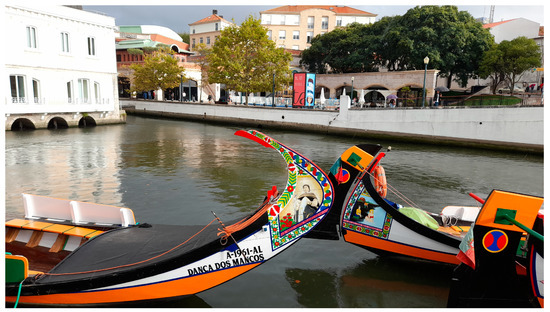
Figure 1.
Moliceiros docked on the Central Canal, Aveiro (Source: author’s own photo, 2022).
A candidate for UNESCO intangible heritage recognition, moliceiros are undoubtedly one of the most important cultural symbols of the region. Small and colorful, hand painted with traditional, brightly colored drawings representing historical facts and national figures, images of popular devotion or even displaying paintings of an erotic nature [52], these boats have become the core element of the city’s tourist activity.
In fact, one could safely say it was tourism that rescued the most prominent cultural artefact of the region from oblivion. Having grown up a stone’s throw away from the main canal, the author has very clear memories of the few vessels that were docked in the city center during the 1980s–1990s; looking decrepit and abandoned, those boats resembled a lonely remnant of the past in a city that was stagnant and had a very limited cultural offering. However, since the turn of the millennium and the boost in national tourism, these boats have gained new life and are now part of the thriving business of boat tours along the city canals. Moreover, to keep up with increasing demand (in 2019, 1.2 million visitors climbed aboard one of these boats), not only were the old shipyards reactivated (involving the recovery of old, manual manufacturing techniques), but new boarding platforms were also built along the main canals [8].
Due to its ideal geographic location for salt production, the mineral has always played an important role in the economy of the region. In the 12th century, Portuguese salt was regarded as a high-quality product in various parts of the world, with the Ria important for the national economy since it provided enough salt not only for internal consumption but also for large exports abroad [53]. There was still a sizeable industry in the 1960s, with about 270 companies producing more than 90 tons per year. However, from then onward, the activity declined significantly; in 1994, the number of active salt pans was reduced to 49, and presently, only 9 remain, which preserve the tradition using artisanal methods of collecting salt.
Now, tourists can visit an eco-museum and learn about the salt extraction process, join guided tours and watch an actual marnoto, salt master, as he scrapes the drying salt with traditional tools and gathers it into large pyramid-shaped mounds. The figure of the salt master is here of utmost importance: by skillfully demonstrating his craft, he is the local authority that gives authenticity to the scene, forming the core of the cultural experience. As Ref. [18] (p. 11) underlines, the involvement of local communities is an important factor for visitor satisfaction and a prerequisite for product development. Local communities are not just the hosts of tourism but also participate directly in the tourism experience, helping to define the sense of place and atmosphere of a region.
In Aveiro, tourists are also invited to amble around the pans, visit a salt spa and bathe in saltwater or mud, taking advantage of the therapeutic properties of sea salt. From a tourists’ perspective, this offers a chance to experience an adventure and, simultaneously, participate in local culture by immersing themselves in the past, in the collective memories that constitute the identity of the locals.
On the whole, by recovering core elements of the region’s identity, Aveiro has reinvented itself, which has led to notable touristic, economic and social development, especially during the last decade. A basis for commercial activity [54], a personal experience for the tourist [55], a carrier and exponent of collective memory [56] and a strengthening mechanism for the identity of residents [57], all in all, culture and cultural heritage have been of fundamental importance both for the tourism and travel sector and at a socioeconomic level. Specifically, in the city of Aveiro, an important positive cycle has been created: as the increasing number of visitors are offered a varied choice of venues to learn and experience local history and traditions, the revenue brought by these visitors not only contributes to regional socioeconomic development but is also directed into culture preservation and the creation of new means to exhibit (and profit from) local natural resources and cultural heritage. Simultaneously, a sense of belonging and local pride, as well as a strengthened collective identity, are also attained.
3. Street Art as a Creative Space of Self-Identification
A broad category that encompasses and originates from graffiti and street art, urban art is on the rise more than ever before and becoming a pervasive element of many urban environments [10], though writing and painting in public spaces are not recent phenomena. In fact, from prehistoric cave paintings or Roman epigraphs to the impressive Mexican muralism movement that emerged in the 1920s, fascist propaganda, New York’s urban hip-hop graffiti from the 1970s, Berlin’s East Side Gallery depicting the 1989/1990 political changes or the social and political criticism present in more recent artworks, city walls have long been important channels for visually conveying personal and political messages [58,59,60,61,62]. Relevant examples of our times are the Black Lives Matter protests of 2020, which spurned countless urban art tributes to George Floyd, or Banksy’s response to the current war in Ukraine, produced by defying the aggressors and creating several artworks in devastated buildings of Kyiv and other bombed locations.
Originally perceived as rebellious manifestations and associated with decay, today, “graffiti and street art oscillate in a fleeting space between illegality and establishment”, “between social criticism and artistic aesthetics” [63]. Distinguishing these two forms can be quite challenging; on this point, Ref. [64] (p. xxxi) admits that both graffiti and street art are complex and confusing, resulting in “the very impossibility in defining them”. Nevertheless, and while they share an entwined co-existence and overlap technique-wise in many ways, we can note important differences.
Both forms represent ephemeral artistic experiences that emerge in public spaces and often evolve around sociopolitical and identitarian issues (hence, the blurred line between the two forms), but their basic intents are distinct. On the one hand, graffiti artists (or “writers”) seek self-expression through the act of leaving individualized signatures (or “tags”) and, generally, do not seek public recognition; in fact, many remain anonymous. Their personal statements, where letters and characters predominate, are not about pleasing an audience; to earn respect within the group (or “crew”) and subculture, rather than the dominant culture, is the main objective of their unauthorized and, therefore, illegal pieces [65,66]. In contrast, street art, which tends to be more image-based, is usually created with permission and has a public audience with whom the artist seeks to engage. Frequently commissioned by city officials or made in partnership with organizations or brands (sometimes to discourage illegal graffiti), murals are the most recognizable form of street art; stained glass, sculptures, installations, yarn bombing or video projections are also media through which street artists seek not only recognition but also interaction with the community [64]. In brief, whereas graffiti marking and writing function as a coded dialogue among members of the movement [67], a secret language [68] or internal communication medium that is illegible to outside members of this scene, street art communicates legible messages to a general public, requiring no connection to subcultural codes [67,68].
This paper aims to focus specifically on the visual messages that fall within the street art form. It is difficult to mark the inception of street art, which Ulrich Blanché, cited in [60], defines as “self-authorized pictures, characters and forms created in or applied to surfaces in the urban space that intentionally seek communication with a larger circle of people done in a performative and often site-specific, ephemeral and participatory way”. Traditionally either admired or frowned on, recently, street art expressions have come to be considered through a new lens, joining the urban art category. Such addition, or “elevation process” [69], is the outcome of legitimation and institutionalization, resulting from a shift in the understanding of this art form and its objectives. This shift is closely linked with the emergence of a new tourist profile—one that is eager for off-the-beaten-track tourist routes [70], alternative public spaces [71] and participative experiences that allow for different connections with the visited places and the locals’ history and identity. In this respect, Ref. [9] (p. 499) underlines that “the local identity, the tangible and intangible heritage rooted in the destination, are the most coveted and appreciated images for tourists, as they reveal the singularity of a place, differentiating it from elsewhere in the globalized, homogeneous world”.
All in all, street art has evolved into an instrument of urban regeneration intended to grace a public space [9], serve as a mechanism for the revitalization of marginalized neighborhoods [69], construct a sense of beauty and encourage belonging [62] and offer a tourist resource of important economic value along with significant power in the development of a city’s character [69]. Furthermore, street art is not only a phenomenon that has been repositioned as a strategic commodity for urban development3 [73] by transforming the urban landscape; while engaging the public in transformative conversation [74], it also creates an important dialogic space for the community. As Ref. [60] suggests, street art “appears in the everyday, capturing our attention and seeking communication with, and from, audiences. Artists use the urban environment as a canvas to create artworks that reflect life and respond to events around them”. Through these interactions, street art gains the capacity to promote critical learning and community among participants [61]. Through the dialogues generated, one can question the values of a city, a region or a society [75], as well as infer the social, political or economic concerns of the community.
This paper originates precisely from one of those dialogues.
As a method, autoethnography can be conceptualized as a representation of social and cultural life by cultural insiders [76]. In this sense, it combines characteristics of ethnography, i.e., the study of a culture’s practices, values and beliefs and cultural participants’ shared experiences [13], with the researcher/insider’s personal understanding of those elements. Both a process (approach to research) and a product (writing) [13], autoethnographic studies imply the description and critical analysis of personal experiences in order to make sense of a given cultural setting where the researcher is also an active member. In this context, the researcher plays the dual role of an authoritative witness and the analysand/interpreter, who position him/herself in-between, in a third space [50], where firsthand knowledge and personal insight are translated into retrospective, critically distanced reflections.
Ref. [13] also suggest that every so often autobiographers write about “epiphanies”, that is, about occurrences they perceive as significantly impactful, events that require the subject to analyze lived, at times transformative, events. As a cultural scientist with a research interest in autobiographical literary representations of memory and identity, one could say that the author’s autoethnographic approach to street art results from one of these fragments of actual life—or an “epiphanic” moment, for that matter.
Just a few years ago, Giovanni Bragolin’s “The Crying Boy” was one of the first works to emerge in the city of Aveiro and cover one of its crumbling, neglected walls (Figure 2). To younger generations, such as my teenage son and daughter, this image held no particular meaning—but it did catch their attention and made them inquire about the significance of a portrait that is part of their parents’ childhood imagery.
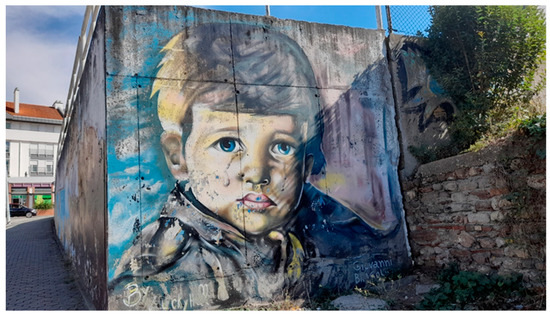
Figure 2.
“The Crying Boy” by Lucky Hell, 2016 (Source: author’s own photo, 2022).
Revisiting “The Crying Boy” that day felt like a journey to the past, to the memory of that haunting, anguished look. To my children, I explained that during the 1970s and 1980s, nearly every Portuguese home had a replica of a painting that, in truth, puzzled and scared all of us, even those who were unaware of the multitude of myths and urban legends associated with it. We had one in the corridor, right in front of my bedroom door, and, most times, I averted my gaze from it. They found the deco trend equal parts strange and amusing and wanted to learn more about what it was like to grow up in those years. Shortly after, I found myself taking a walk down memory lane and describing my childhood, telling them about other trends and people’s views, habits and traditions back then in the aftermath of a 40-year fascist dictatorship.
That portrait triggered intergenerational sharing and transmission of elements that ultimately constitute my identity as well as that of an entire generation of individuals. Many of us were raised by parents who lived anxious lives under a repressive regime, struggling to feed and clothe their large families in a mostly rural society with poor literacy skills, limited life prospects and a colonial war (1961–1974) they could not contest hanging over their heads, consuming their already scarce resources and tearing families apart. This reality is now unimaginable but indirectly also part of who many people are today. Poor life conditions and emigration, which became a self-preservation strategy for many Portuguese families (especially from the 1960s onwards), deeply molded my parents’ generation, and that past also shaped people of my generation’s personalities, vision and stance in many aspects of life.
Other street artworks have since been created, gradually taking over many corners and streets of the city. Interestingly though, contrary to what has happened in other urban centers, there are few examples of works with political messages or marked by rebellious intent or controversy. Most of the created pieces portray ethnographic elements of the region and celebrate true stories and people who lived a reality that is still close to us—e.g., the fishing tradition or the cod fish drying process in the neighboring city of Gafanha da Nazaré (Figure 3 and Figure 4)—yet so distant already. The candid conversation I had with my children back then, as well as the others that followed over the years whenever we passed a new art piece, resulted from those invaluable “texts”, as defined by Roland Posner in his semiotic culture model [47], where such visual artworks (alongside architecture, literary and legal texts and other artefacts) constitute the material dimension of one’s culture.
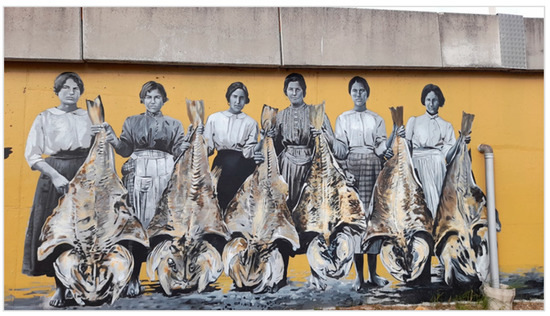
Figure 3.
Women and the cod drying process, by urban artist António Conceição, 2020 (Source: author’s own photo, 2022).
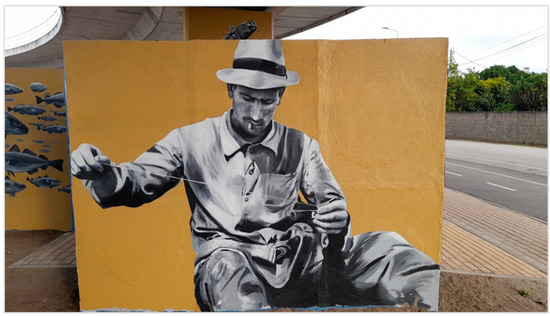
Figure 4.
The fishing tradition: repairing fishing nets, by urban artist António Conceição, 2020 (Source: author’s own photo, 2022).
As a means to boost the attractiveness of a place and improve its destination/brand image, street art encourages not only tourists but also residents to visit local neighborhoods and businesses. In addition, the integration of culture and arts in urban public spaces plays an important role in shaping a city’s image and identity [77]. In the end, a mural does not only change the visual aesthetic of an area and bring new life to a neighborhood but also acts as a bearer of memory bearer, as well as creates a dialogic space that helps shape and define the idea of community through a renewed sense of identity, with the culture or essence of a given group celebrated and passed on to the next generation.
Even though there is not yet clear agreement on a conceptualization of street art as cultural heritage [77], one thing seems to be true: this art form has been socially recognized in its cultural and aesthetic potential by most media, municipalities, authorities, academia and institutions [58,77]. Moreover, as art takes over the streets, tangible and intangible elements of our culture are passed on from generation to generation, ensuring that a continuity line is drawn. Figure 5 illustrates one of the most recent examples of this in Aveiro, with the images of the national fado singer, Amália Rodrigues, and one of the most prominent Portuguese poets, Fernando Pessoa. These have been brought to the picturesque Fish Market Square, the place where tradition and modernity meet, and the neighborhood where, for many generations, students have chosen to gather at night.
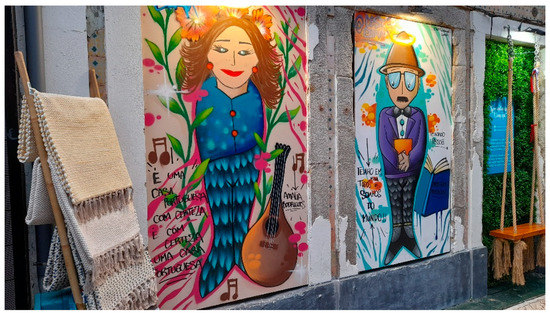
Figure 5.
Amália Rodrigues and Fernando Pessoa, by street artist Cest Esteban, 2022 (Source: author’s own photo, 2022).
In Aveiro, in artworks created by António Conceição (Figure 3 and Figure 4), Fábio Carneiro (Figure 6, Figure 7 and Figure 8), Zooter (Figure 9) or Vihls (Figure 10), life and art meet to forge a dialogue between the past and the present. Their works constitute a repository of national and local symbols, values, traditions and ways of life, where many core elements of the community’s identity are celebrated and transmitted, not only to visitors but also to younger generations as well—thus supporting the line that creates the sense of continuity, as mentioned before. By integrating these elements into the urban landscape, each of their pieces allows for an experience of immersion into history, and the narratives they render may inspire reflection—which meets the cognitive interests of the modern tourist [9]—as well as raise awareness of the portrayed community members and their practices, values and beliefs.
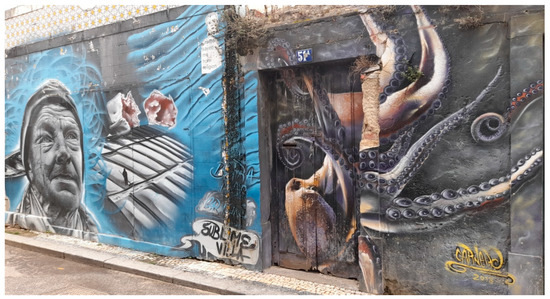
Figure 6.
Tribute to fishermen, by Fábio Carneiro, 2013 (Source: author’s own photos, 2022).
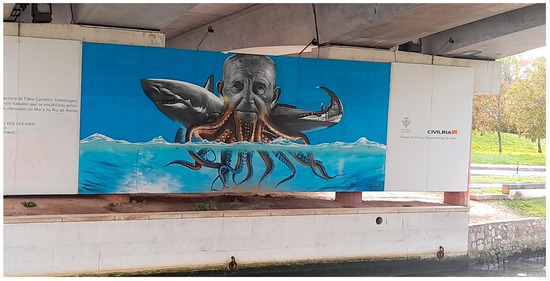
Figure 7.
Tribute to Atita, by Fábio Carneiro, 2014 (Source: author’s own photos, 2022).
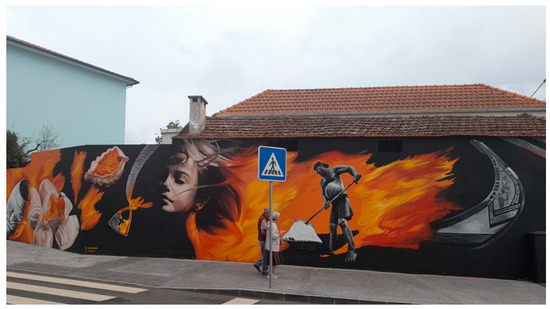
Figure 8.
Aveiro’s identitary elements, by Fábio Carneiro, 2021 (Source: author’s own photos, 2022).
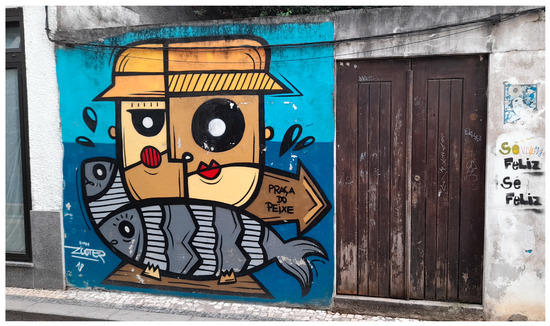
Figure 9.
Fish market, by Zooter, 2018 (Source: author’s own photo, 2022).
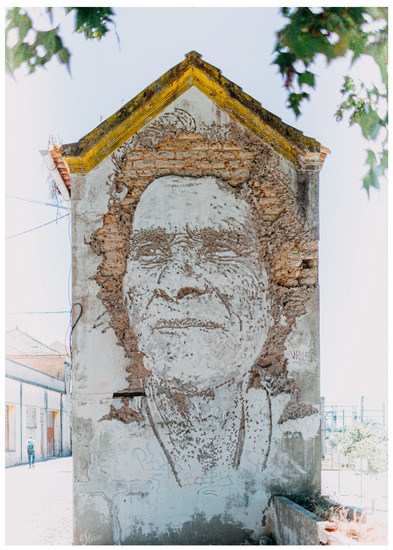
Figure 10.
“Scratching the Surface Project: Dona Florinda” by Vhils (Source: Courtesy of Turismo Centro de Portugal).
Alongside the anonymous faces that are representative of men and women carrying out our local activities (in this instance, fishermen, women working in the codfish drying sheds, salt workers and fishmongers), in Figure 8, homage is paid to Eduardo de Sousa (1932–1917). Locally known as Atita, he is admired by different generations of aveirenses, the natives/inhabitants of Aveiro. Dubbed “the shark of the seas”, he is remembered by many as a swim teacher who saved many lives off the shore and the Ria, and the man who, at the age of 85, was still a sports enthusiast, radiating positive energy every Sunday morning on the beaches of the municipality of Ílhavo. As a tribute to him, every year on New Year’s Day, hundreds of locals take to the shore for their first swim of the year—an initiative that was launched by Atita over four decades ago.
Another remarkable example of a tribute to a local figure is “Dona Florinda” (Figure 10), specially created for the 2017 Estarreja Urban Art Festival. Known worldwide for his impressive wall carvings [78], Alexandre Farto—aka Vihls—pays homage to a local woman of the municipality of Estarreja who, together with her husband, is the last producer to employ traditional farming methods in the cultivation of rice in the Ria fields, today protected as a National Ecological Reserve and National Agricultural Reserve. This work serves as a tribute to the past, as well as a reminder of the importance of preserving natural ecosystems.
Gone are the days when Zooter’s first work (Figure 9) had to be fiercely defended by residents of the Fish Market neighborhood because authorities had declared it an illicit act and issued a fine [79]. Fast forward a few years, street art has been fully legitimized and transformed into an appreciated cultural product. The street art trail has not only gained an official route status, awarded by the National Tourism Office [2], but is also one of the most important components of Festival dos Canais [80], the multidisciplinary arts festival organized every July in Aveiro. Equally interesting is the case of AgitÁgueda [81], another summer arts festival organized by the neighboring city of Águeda, where streets are filled with an impressive number of urban art installations, transforming the city into a colorful open-air art gallery for three weeks. Also noteworthy is the enthusiastic support from the community: not only these festivals attract many local visitors, but every time a street art piece is mentioned on social media, either in community groups, on artists’ pages (Figure 11 and Figure 12) or by any local news media, the reception is generally very positive as well.
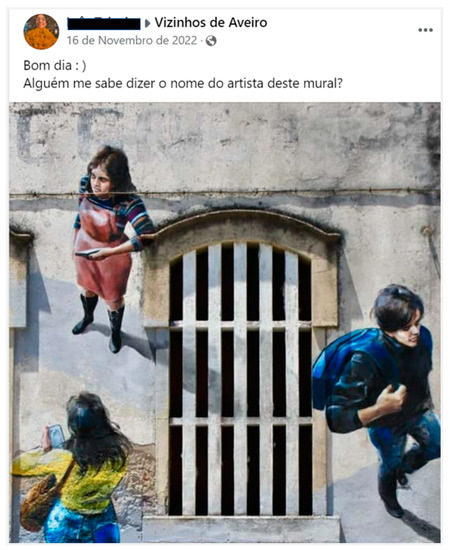
Figure 11.
Member inquiring about the authorship of a work (Source: Facebook group Vizinhos de Aveiro/Aveiro Neighbors).
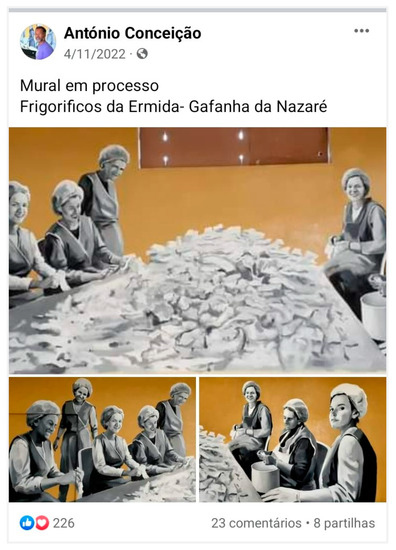
Figure 12.
“Work in progress” (Source: A. Conceição Facebook page. Courtesy of the artist).
The ubiquitous presence of technology, along with the concomitant rise of social media, has not only shaped the way we live, work and interact with each other but has also played an important part in the process of acceptance and legitimization of this art form. Through popular, visually-oriented platforms such as Facebook, Twitter, Instagram and TikTok, artists have found powerful means to showcase their ongoing or complete works, engage with audiences and increase their following. Simultaneously, these are also the media of choice for passersby and admirers to share photographs and/or participate in conversations about pieces that have particularly resonated with them. In the same vein, along with the regular use of social media to promote street art festivals and events, official entities also organize virtual street art tours over social media and encourage visitors to spread the word through these platforms. An interesting example from the region is the city of Águeda, which claims to be the world’s most colorful city, precisely because of its street artworks and all-year-round urban artistic installations: in its Urban Art app [82], users are invited not only to visit the city’s artworks and capture their experience on camera but also to share that on social media.
4. Concluding Remarks
Over recent years, street art has gained increasing visibility. In Aveiro, it has been successfully used as a medium to enhance the cultural vibrancy of a region where the socioeconomic impact of tourism is very significant. An important agent of development, tourism can be defined as the movement of people to countries or places outside their usual environment for personal or business/professional purposes. Cultural tourism, in particular, has become one of the largest and fastest-growing global tourism markets and one of the segments that has expanded notably in Portugal.
This positive trend has occurred in part due to the new tourism profiles that have emerged over the last decades. Contemporary, global tourists are active and opt for leisure activities that allow exploration, growth, renewal, reflection and self-actualization. Keen on the emotional dimension of tourism, these tourists seek experiences that allow them to connect with local communities and their ways of living. Given this growing interest in local history, collective memories and identity, culture and tourism have developed a mutually beneficial relationship, one that can strengthen the attractiveness and competitiveness of a place and, simultaneously, enhance culture itself by creating an income to support cultural heritage, cultural production and creativity.
The concept of cultural memory is central in this context. Memory can be defined as the ability to form an awareness of selfhood or identity, both at the personal and the collective levels. Individual identity is herein understood as a structure of the self that is built on interaction with others within a particular cultural context. In this way, identity consciousness is translated into a feeling of permanence and continuity that the individual experiences in one’s personal relations, as well as through the recognition of others within various social interactions.
The concept of identity also points to the notion of “being identical” to someone else, i.e., sharing a set of characteristics with them. Language, history, customs and traditions common to a specific group are thus shared cultural elements and, therefore, distinctive features of a collective identity. Two different mechanisms may contribute to the construction of one’s collective identity: (1) through communicative memory, i.e., everyday interactions with elder members of the group who experienced or observed events relevant to the community; and (2) through cultural memory, i.e., documents, artefacts, images, rituals, etc., that may be drawn on during festivities or ceremonials.
A nuisance for some, transformative for others, street art can be an instrument of urban regeneration used to grace a public space, a mechanism for the revitalization of marginalized neighborhoods or a means to construct a sense of beauty and encourage belonging. In recent times, it has also become a tourist resource of strategic economic value. In the context of this article, street art is analyzed as a medium that plays an important role in shaping a community’s image and identity. It is understood as a mechanism of communicative memory and a dialogic space that invites the community members to recall identitarian elements and hand these down to younger members of the group. To address the role of street art through this lens and offer an analytical interpretation and meaning, the author, who has always been a member of this community, adopted an autoethnographic approach.
In Aveiro, street art has become a cultural product of major importance. The street art trail has not only gained an official route status that is fully integrated into the national tourism strategy but has also become of the most prominent elements in many of the events organized in the region. The public’s response every time a piece is completed and the encouragement artists receive during the creation process are also evident, especially in the digital world—it is mostly here, in this constantly expanding gallery of artworks, that engagement begins, art is preserved and artists increase their exposure.
All in all, the street artists whose works adorn the walls of Aveiro have become invaluable storytellers. These are memory walls that tell the story of the community—like moliceiros, ceramic walls and cobblestone pavements have been doing for many generations. It has been suggested in this article that, beyond instruments of urban regeneration or tourist attractions, each of these visual artworks has also encouraged inter- and intragenerational dialogues about common history, knowledge, traditions and practices of emotional significance—conversations that, ultimately, have helped weave the tapestry of what this community has become.
Funding
This research was funded by FCT—Fundação para a Ciência e a Tecnologia, Ministério da Ciência, Tecnologia e Ensino Superior, Portugal, through project UIDB/04188/2020.
Data Availability Statement
Not applicable.
Acknowledgments
The author would like to thank the Languages, Literatures and Cultures Research Centre of the University of Aveiro (CLLC-UA), especially the coordinator of the Globalization and Identities Project, Professor Gillian Moreira, for her invaluable support and motivation.
Conflicts of Interest
The author declares no conflict of interest.
Note
| 1 | Although enjoying a unique and real experience is in many cases a visitor’s greatest expectation, in reality, such experiences cannot be considered “authentic”, at least, not in the strict sense of the word [8]. One cannot mimetically replicate the past, only construct a fictionalised version of it; therefore, authenticity in this context is rather a “staged authenticity” (MacCannell, as cited in [32]) or pieces of a “migrating heritage” [33]. Either way, tourism experiences are not supposed to be mimetic representations of the past; there is a tacit understanding that the offered experiences are rather recreations or interpretations of the past, filtered through the host’s memory and adapted to the present moment’s circumstances and resources. More importantly, they may not be authentic sensu stricto, but they are a “homage” [32] to the original concept that is being shared by the locals, the recipients of that heritage—i.e., the witnesses of a time and place they might have not personally experienced, but that they have received through collective and communicative memory mechanisms [8]. |
| 2 | In the context of the subject matter discussed herein, the notion of anonymity is of particular importance. It is not uncommon for graffiti writers or street artists to create anonymously or as a collective; many do this for legal protection since many works are composed without permission, and others follow that route to create a sense of mysticism. Withholding one’s identity may also serve the purpose of amplifying the conveyed social or political messages rather than having the focus on the artist themselves [39]. For UK-based Banksy, for example, anonymity is part of their character; having started out in the 1990s as a stencil graffiti artist, they have become one of the most influential names on the street art scene, with their politically charged pieces and comments on current issues raising public awareness of inequities and injustices. |
| 3 | GAU—the Urban Art Gallery, created in 2008 by the Lisbon City Council, is an impressive example of the acceptance and elevation of street art, which have made Lisbon one of the most relevant cities in the world as far as urban art is concerned. Under the Council’s Department of Cultural Heritage, GAU “has as its main mission the promotion of graffiti and Street Art in Lisbon, in an official and authorized scope and in a pathway of respect for the patrimonial and landscaped values, in opposition with the illegal acts of vandalism that harm the City” [72]. Quinta do Mocho, for example, once a marginalized Lisbon neighbourhood, is now “one of the most contemporary and interesting examples of street art touristification that the multicultural neighborhoods of Greater Lisbon have experienced in recent years” [73]. A recent initiative that illustrates this engagement with the public is the urban art project Alfa Bravo (www.alfabravo.pt): on 15 May 2022, around 200 people united for one of the largest participatory art projects at nationally, which helped revitalize one of Lisbon’s busiest streets. According to the organizers, the initiative was more than the transformation of a 4 km wall; it was also an art and social project that brought citizens and the city closer. The resulting wall is intended to break down barriers and include everything and everyone that passes by it. |
References
- Center of Portugal. Aveiro. Available online: https://www.centerofportugal.com/destination/aveiro (accessed on 10 December 2021).
- Center of Portugal. Street Art Route. Available online: https://www.centerofportugal.com/tour/street-art-route (accessed on 10 December 2021).
- Castillo-Villar, F.R. Urban icons and city branding development. J. Place Manag. Dev. 2016, 9, 255–268. [Google Scholar] [CrossRef]
- Henninger, C.E.; Foster, C.; Alevizou, P.J.; Frohlich, C. Stakeholder engagement in the city branding process. Place Brand. Public Dipl. 2016, 12, 285–298. [Google Scholar] [CrossRef]
- Kasapi, I.; Cela, A. Destination branding: A review of the city branding literature. Med. J. Soc. Sci. 2017, 8, 129–142. [Google Scholar] [CrossRef]
- Kavaratzis, M. From city marketing to city branding: Towards a theoretical framework for developing city brands. Place Brand. 2004, 1, 58–73. [Google Scholar] [CrossRef]
- Riza, M.; Doratli, N.; Fasli, M. City branding and identity. Procedia-Soc. Behav. Sci. 2012, 35, 293–300. [Google Scholar] [CrossRef]
- Simões, A.V. The synergy between tourism and culture: The revival of local identities as driver of attractiveness and regional development. In Transcultural Mobilities and Memories; Paisana, J., Matos, M., Eds.; Edições Húmus: Vila Nova de Famalicão, Portugal. (in press)
- Crespi Vallbona, M.; Miró, O.M. Innovation in tourism market: Experiences in street art. Cuad. De Tur. 2021, 48, 497–499. Available online: https://www.proquest.com/openview/f4d906e7e29ad937309818d4706f1a0e/1?pq-origsite=gscholar&cbl=2035771 (accessed on 30 September 2022).
- Cercleux, A.-L. Street Art Participation in Increasing Investments in the City Center of Bucharest, a Paradox or Not? Sustainability 2021, 13, 13697. [Google Scholar] [CrossRef]
- Palazzo, A.L. Culture-Led Regeneration in Rome: From the Factory City to the Knowledge City. Int. Stud. 2017, 19, 13–27. [Google Scholar] [CrossRef]
- Brown, B. Re-Picturing the “Post-Fordist” Motor City: Commissioned Street Art in Downtown Detroit. Archit. MPS 2017, 12. [Google Scholar] [CrossRef]
- Ellis, C.; Adams, T.E.; Bochner, A.P. Autoethnography: An Overview. Forum Qual. Soz./Forum Qual. Soc. Res. 2010, 12, 10. Available online: http://nbn-resolving.de/urn:nbn:de:0114-fqs1101108 (accessed on 20 January 2021).
- Barrett, A.; Kajamaa, A.; Johnston, J. How to … be reflexive when conducting qualitative research. Clin. Teach. 2020, 17, 9–12. [Google Scholar] [CrossRef]
- Olmos-Vega, F.M.; Renée, E.; Stalmeijer, R.E.; Varpio, L.; Kahlke, R. A practical guide to reflexivity in qualitaive research: AMEE Guide No. 149. Med. Teach. 2022, 45, 3. [Google Scholar] [CrossRef]
- Assmann, J. Communicative and Cultural Memory. In Cultural Memory Studies. An International and Interdisciplinary Handbook; Erll, A., Nünning, A., Eds.; De Gruyter: Berlin, Germany, 2008; pp. 109–118. [Google Scholar]
- OECD. Tourism Trends and Policies; OECD Publishing: Paris, France, 2020; Available online: https://www.oecd.org/cfe/tourism/OECD-Tourism-Trends-Policies%202020-Highlights-ENG.pdf (accessed on 20 January 2021).
- OECD. The Impact of Culture on Tourism; OECD Publishing: Paris, France, 2009; Available online: https://www.oecd.org/industry/the-impact-of-culture-on-tourism-9789264040731-en.htm (accessed on 20 January 2021).
- Carvalho, R.; Ferreira, A.M.; Figueira, L.M. Cultural and Creative Tourism in Portugal. PASOS Rev. Tur. Y Patrim. Cult. 2016, 14, 1075–1082. [Google Scholar] [CrossRef]
- UNWTO. Glossary of Tourism Terms. Available online: https://www.unwto.org/glossary-tourism-terms (accessed on 13 February 2023).
- Coccossis, H. Cultural heritage, local resources and sustainable tourism. Int. J. Serv. Technol. Manag. 2008, 10, 8–14. [Google Scholar] [CrossRef]
- Eusébio, C.; Carneiro, J.C. Impactos socioculturais do turismo em destinos urbanos. Rev. Port. Estud. Reg. 2012, 30, 65–75. [Google Scholar]
- Costa, C. The Impact of the COVID-19 Outbreak on the Tourism and Travel Sectors in Portugal: Recommendations for Maximising the Contribution of the European Regional Development Fund (ERDF) and the Cohesion Fund (CF) to the Recovery. Final Report. European Commission. 2021. Available online: https://www.portugal2020.pt/wp-content/uploads/ccosta_for_ec.covid-19.report_txt.final_.pdf (accessed on 1 December 2022).
- Word Bank. Portugal Tourism Statistics 1995–2021. Available online: https://www.macrotrends.net/countries/PRT/portugal/tourism-statistics (accessed on 12 November 2022).
- Turismo de Portugal. Desempenho Turístico 2019. Available online: http://business.turismodeportugal.pt/pt/Conhecer/Apresentacao/Desempenho_Turistico/Paginas/default.aspx (accessed on 12 April 2021).
- Silva, M.L. Turismo em Portugal/Estimativas Rápidas. TravelBI Turismo de Portugal. 2022. Available online: https://travelbi.turismodeportugal.pt/turismo-em-portugal/estimativas-rapidas-julho-2022/ (accessed on 1 December 2022).
- INE. Atividade Turística. Dormidas Ultrapassam os Níveis de 2019 em Todas as Regiões, Exceto no Algarve. Instituto Nacional de Estatística, 14 September 2022. Available online: https://www.ine.pt/xportal/xmain?xpid=INE&xpgid=ine_destaques&DESTAQUESdest_boui=539848973&DESTAQUESmodo=2 (accessed on 20 January 2021).
- Petronilho, A. Receitas do Turismo 27.2% Acima de 2019 com o Aumento dos Preços. Jornal de Negócios, 14 December 2022. Available online: https://www.jornaldenegocios.pt/empresas/turismo---lazer/detalhe/receitas-do-turismo-272-acima-de-2019-com-o-aumento-dos-precos (accessed on 1 December 2022).
- Costa, C. Turismo e cultura: Avaliação das teorias e práticas culturais do sector do turismo (1990–2000). Álise. Soc. 2005, 175, 279–295. [Google Scholar]
- World Leisure Organization, About Us. 2019. Available online: https://www.worldleisure.org/about-us/ (accessed on 13 February 2023).
- Wilson, J. The emotional dimension of the tourist experience. In Routledge Handbook of the Tourist Experience; Sharpley, R., Ed.; Routledge: London, UK, 2021; pp. 37–49. [Google Scholar] [CrossRef]
- Chhabra, D.R.; Healy, R.; Sills, E. Staged authenticity and heritage tourism. Ann. Tour. Res. 2003, 30, 702–719. [Google Scholar] [CrossRef]
- Innocenti, P. Cultural Network in Migrating Heritage; Ashgate Publishing: London, UK, 2015. [Google Scholar]
- Sarmento, C. Tourism as Intercultural Business: Locating Concepts and Questioning Identities. Eur. J. Sustain. Dev. 2020, 9, 400. [Google Scholar] [CrossRef]
- Global Heritage Fund. Why We All Need to Travel with Purpose. 2009. Available online: https://globalheritagefund.org/2019/09/27/why-we-all-need-to-travel-with-purpose/ (accessed on 1 December 2022).
- UNWTO. Tourism and Culture Synergies; World Tourism Organization: Madrid, Spain, 2018. [Google Scholar]
- European Cultural Tourism Network. Thessalia Charter for Sustainable Cultural Tourism, 2nd ed.; 2016; Available online: https://www.culturaltourism-network.eu/thessalia-charter.html (accessed on 1 December 2022).
- UNESCO. Convention Concerning the Protection of the World Cultural and Natural Heritage. In Proceedings of the General Conference at its 17th Session, Paris, France, 16 November 1972; United Nations Educational, Scientific and Cultural Organization: Paris, France, 1972. [Google Scholar]
- Chackal, T. Of Materiality and Meaning: The Illegality Condition in Street Art. J. Aesthet. Art Crit. 2016, 74, 359–370. [Google Scholar] [CrossRef]
- The Charter of Krakow. Principles for Conservation and Restoration of Built Heritage. 2000. Available online: https://www.triestecontemporanea.it/pag5-e.htm (accessed on 1 December 2022).
- Cervik, S. Dirty Dance: Tourism and Environment. IMF Working Papers. Int. Monet. Fund 2022, 2022, 178. [Google Scholar] [CrossRef]
- Cultural Heritage in Action. Cultural Tourism in Post-Covid Cities towards More Sustainable Patterns. 2022. Available online: https://culturalheritageinaction.eu/cultural-tourism-in-post-covid-cities-towards-more-sustainable-patterns/ (accessed on 1 December 2022).
- Madeira, A.; Palrão, T.; Mendes, A.S.; López-Morales, E. Perceptions about Tourism and Tourists in Historic Neighborhoods: The Case of Alfama. Sustainability 2021, 13, 8357. [Google Scholar] [CrossRef]
- Magazine Imobiliário. Aveiro Foi o Município com o Maior Crescimento nos Preços dos Imóveis. 2022. Available online: http://www.magazineimobiliario.com/imobiliario/aveiro-foi-o-municipio-com-o-maior-crescimento-nos-precos-dos-imoveis/ (accessed on 14 January 2023).
- Simões, A.V. Identity and belonging in the novels of Doron Rabinovici. Polissema-Revista de Letras 2012, 12, 39–56. [Google Scholar] [CrossRef]
- Booth, W.J. Communities of Memory: On Witness, Identity, and Justice; Cornwell University: Ithaca, NY, USA, 2006. [Google Scholar]
- Simões, A.V. O Lugar da Memória na Obra de Jovens Autores de Expressão Alemã. Ph.D. Thesis, University of Aveiro, Aveiro, Portugal, 2009. [Google Scholar] [CrossRef]
- Hall, S. The question of cultural identity. In Modernity and Its Futures; Hall, S., Held, D., McGrew, A.G., Eds.; Open University: Cambridge, UK, 1992; pp. 273–316. [Google Scholar]
- Hall, S. Cultural identity and diaspora. In Colonial Discourse and Post-Colonial Theory: A Reader; Williams, P.L., Chrisman, L., Eds.; Columbia University Press: New York, NY, USA, 1994; pp. 222–237. [Google Scholar]
- Holliday, A. Contesting Grand Narratives of the Intercultural, 1st ed.Routledge: London, UK, 2021. [Google Scholar] [CrossRef]
- Castiñeira, Á. Naciones imaginadas. Identidad personal, identidad nacional y lugares de memoria. In Casa Encantada: Lugares de Memoria en la España Constitucional (1978–2004).; Ramon, R.J., Winter, U., Eds.; Vervuert Verlagsgesellschaft: Frankfurt, Germany; Madrid, Spain, 2017; pp. 41–78. [Google Scholar] [CrossRef]
- Sarmento, C. Quadros flutuantes: Os moliceiros da Ria de Aveiro. Câmara Municipal de Aveiro: Aveiro, Portugal, 2000. [Google Scholar]
- Rodrigues, C.M.; Bio, A.; Amat, F.; Vieira, N. Artisanal salt production in Aveiro/Portugal—An eco-friendly process. Aquat. Biosyst. 2011, 7, 3. [Google Scholar] [CrossRef] [PubMed]
- Robinson, M.; Smith, M. Cultural Tourism in a Changing World: Politics, Participation and (Re)presentation; Channel View Publications: Clevedon, UK, 2006. [Google Scholar]
- Weaver, D.B. Contemporary tourism heritage as heritage tourism. Ann. Tour. Res. 2011, 38, 249–267. [Google Scholar] [CrossRef]
- Walsh, K. The Representation of the Past. Museums and Heritage in the Post-Modern World; Routledge: London, UK, 1992. [Google Scholar]
- Selwyn, T. The Tourist Image: Myths and Myth Making in Tourism. John Wiley & Sons: Chichester, UK, 1996. [Google Scholar]
- Sarmento, C. StreetArtCEI—Routes of Graffiti and Street Art in Porto and Northern Portugal. In Cultural Tourism and Heritage in Northern Portugal; Sarmento, C., Pascoal, S., Eds.; Cambridge Scholars Publishing: Newcastle upon Tyne, UK, 2020; pp. 63–90. [Google Scholar]
- Malott, M.E. How a Few Individuals Brought about a Cultural Cusp: From a Mexican Mural Program to a Movement. Perspect Behav. Sci. 2019, 42, 773–814. [Google Scholar] [CrossRef]
- Beattie, A. Activating the urban environment: A case for street art. Glob. Media J. 2021, 15, 1. Available online: https://www.hca.westernsydney.edu.au/gmjau/?p=3821. (accessed on 10 December 2022).
- Cooper, J.; Sandlin, J. Intra-active pedagogies of publicness: Exploring street art in Melbourne, Australia. Pedagog. Cult. Soc. 2020, 28, 421–443. [Google Scholar] [CrossRef]
- Di Luggo, A.; Zerlenga, O. Street art. Drawing on the walls. DesignareCon 2020, 13. Available online: https://disegnarecon.univaq.it/ojs/index.php/disegnarecon/article/view/849/426 (accessed on 20 January 2021).
- Koller, A. Street Art: How political and rebellious is it today? Topos, 21 April 2022. Available online: https://toposmagazine.com/street-art-political/ (accessed on 10 December 2022).
- Ferrell, J. Foreword: Graffiti, Street Art, and the Politics of Complexity. In The Routledge Handbook of Graffiti and Street Art; Ross, J.I., Ed.; Routledge: New York, NY, USA, 2016. [Google Scholar]
- Campos, R. Pintando a Cidade: Uma Abordagem Antropológica ao Graffiti Urbano. Ph.D. Thesis, Universidade Aberta, Lisbon, Portugal, 2007. [Google Scholar]
- Wacławek, A. Graffiti and Street art (World of Art Series); Thames & Hudson: London, UK, 2011. [Google Scholar]
- McAuliffe, C. Graffiti or street art? Negotiating the moral geographies of the creative city. J. Urban Aff. 2012, 34, 189–206. [Google Scholar] [CrossRef]
- Lewisohn, C. Street Art: The Graffiti Revolution; TATE: London, UK, 2008. [Google Scholar]
- Campos, R.; Sequeira, Á. Urban Art touristification: The case of Lisbon. Tour. Stud. 2020, 20, 182–202. [Google Scholar] [CrossRef]
- Gravari-Barbas, M.; Delaplace, M. Le tourisme urbain ‘hors des sentiers battus’. Coulisses, interstices et nouveaux territoires touristiques urbains. Téoros 2015, 34. Available online: https://journals.openedition.org/teoros/2790 (accessed on 20 January 2021).
- Richards, G. Cultural Tourism Trends in Europe: A Context for the Development of Cultural Routes. In Impact of European Cultural Routes on SMEs’ Innovation and Competitiveness; Khovanova-Rubicondo, K., Ed.; Council of Europe: Strasbourg, France, 2011; pp. 21–39. [Google Scholar]
- Câmara Municipal de Lisboa. Galeria de Arte Urbana (GAU). Available online: http://gau.cm-lisboa.pt/en/gau.html (accessed on 10 November 2022).
- Raposo, O.R. Street Art Commodification and (An)aesthetic Policies on the Outskirts of Lisbon. J. Contemp. Ethnogr. 2022. [Google Scholar] [CrossRef]
- Marr, A. ‘Beauty Is the Street.’ The Evolution of Graffiti Practices in Melbourne, Australia. Master’s Thesis, University of Otago, Dunedin, New Zealand, 2015. [Google Scholar]
- Nikolaï, M. The Importance of Art in Public Spaces. European Forum for Urban Security. 2022. Available online: https://efus.eu/topics/public-spaces/the-importance-of-art-in-public-spaces-by-michael-nicolai/ (accessed on 20 January 2021).
- Gannon, S. Autoethnography. Education 2017. [Google Scholar] [CrossRef]
- Nomeikaite, L. Street art, heritage and embodiment. Str. Art Urban Creat. 2017, 3, 43–53. [Google Scholar]
- Forbes. 30 under 30. Art and Style. Available online: https://www.forbes.com/30-under-30-2015/#/art-style (accessed on 10 November 2022).
- Filipe, S. Aveiro tornou-se uma galeria imprevisível de arte urbana. AveiroMag. 2019. Available online: https://www.aveiromag.pt/2019/03/20/aveiro-tornou-se-uma-galeria-imprevisivel-de-arte-urbana/ (accessed on 20 January 2021).
- European Festivals Association. Festival dos Canais. Available online: https://www.festivalfinder.eu/festivals/festival-dos-canais (accessed on 13 February 2023).
- European Festivals Association. Agitagueda. Available online: https://www.festivalfinder.eu/festivals/agit%C3%A1gueda (accessed on 13 February 2023).
- Agitágueda Urban Art. Available online: https://agitaguedaurbanart.com/en/ (accessed on 16 February 2023).
Disclaimer/Publisher’s Note: The statements, opinions and data contained in all publications are solely those of the individual author(s) and contributor(s) and not of MDPI and/or the editor(s). MDPI and/or the editor(s) disclaim responsibility for any injury to people or property resulting from any ideas, methods, instructions or products referred to in the content. |
© 2023 by the author. Licensee MDPI, Basel, Switzerland. This article is an open access article distributed under the terms and conditions of the Creative Commons Attribution (CC BY) license (https://creativecommons.org/licenses/by/4.0/).